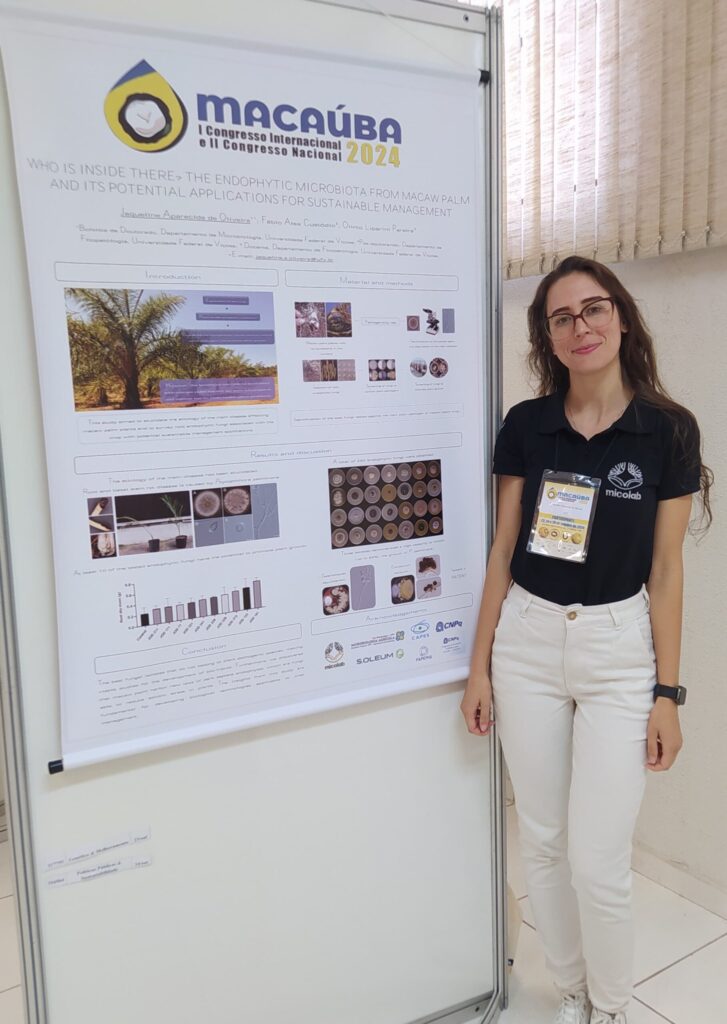
In Campinas, Jaqueline presented the partial results of the research carried out at the Laboratory of Mycology and Fungal Etiology of Plants.
A pioneering study involving fungi that inhabit macauba roots, carried out at UFV’s Laboratory of Mycology and Fungal Etiology of Plants, was presented during the 1st International Congress and 2nd National Congress on Macauba, between October 23 and 25, in Campinas (SP). Developed by Jaqueline Aparecida de Oliveira, a PhD student in the Graduate Program in Agricultural Microbiology (PPGMBA) and coordinated by Professor Olinto Liparini Pereira, the project is the result of the CNPq MAI/DAI program, and promotes a partnership between UFV and the company S.Oleum, dedicated to large-scale macauba production. The main focus of the study is to contribute to the plant’s production chain by using the potential of fungi to fight disease.
“Our first goal was to access and identify, for the first time, the fungi that inhabit the roots of this plant. But one of the main challenges identified in macauba cultivation is the control of root and basal stem rot, a disease that affects seedlings and which until recently was of unknown etiology. So, we elucidated the etiology of the disease in Brazil, identified an oomycete, Phytophthora palmivora, as its causal agent and began to look for fungi found in the plant’s own roots that could help combat the disease,” explains Jaqueline. In all, the PhD student and her work group obtained around 250 isolates from the macauba root. “We did a screening and started testing whether some of these fungi could inhibit the causal agent of the rot. We carried out several tests, and then narrowed down the work until we came up with three that could control root and basal stem rot.” Of these three, two have been described in an article and one is in the process of applying for a patent.
It was these results that Jaqueline went to present at the congress, which was focused exclusively on macauba cultivation. The plant is a native palm that has attracted increasing attention for its ability to produce large quantities of oil, with the potential to serve the biofuel market. “This is a crop that, in a way, is still in the initial process of commercial exploitation. Its main product is vegetable oil, but it is linked to another important issue, which is carbon credit. Macauba produces a lot of biomass and is now seen as an ally in the search for sustainability.”
Jaqueline is currently working on identifying and describing all the new genera and species of fungi found, and on drawing up a patent application for the use of one of the three fungi that showed good results against the phytopathogen tested. The researcher hopes that the discoveries made on the macauba root can also benefit other plants susceptible to the same pathogen. “We also began to study the potential of these fungi to promote growth, in an attempt to understand which ones would help the plant grow or not. We studied this in corn, for example, and came up with ten isolates with the potential to promote plant growth. However, this study is still in the early stages of testing and we need more time to invest in it.”
Also in the coming months, the researcher intends to focus, among the isolates found, on those that have been studied as allies in relieving plant stress. “We know that macauba is home to this type of endophytic fungus – Dark septate endophytese – and we want to delve deeper into both its taxonomic descriptions and potential application tests. And there is another point that goes hand in hand with commercial exploitation: the concern to ensure that the expansion of cultivation is aligned with the principles of sustainability, using as few chemical inputs as possible. With this commitment to fungi, we are using biological technologies for a crop that aims for a sustainable production chain.”

Leave A Comment